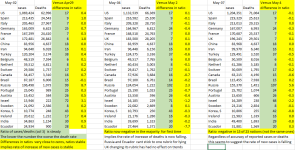Suspect the voluntary mass use of masks is a big one.
I think so too, but our scientists seem not to agree. Or maybe we just haven't got enough supply to cope and so they don't want to mandate it.
Suspect the voluntary mass use of masks is a big one.
That's a tough one but probably not materially different. But they are certainly bigger users of hand sanitisers due to prior experiences with SARS etc.
I think so too, but our scientists seem not to agree. Or maybe we just haven't got enough supply to cope and so they don't want to mandate it.
But they are certainly bigger users of hand sanitisers due to prior experiences with SARS etc.
Apologies for the mess above. I preface this ramble with the health warning that it is just a back of the enveope exercise that may interest a small number of you. My inferences are guesses, because the sources of error in every number are not identifiable. If a particular person feels inclined to stand on high and piss all over this post, there won't be any replies from me because I have my 'ignore' umbrella up.
First, attached is a comparison of April 14 and today's Johns Hopkins data.
View attachment 123231
Compared with Apr 14, the fall in ratio of total number of recorded cases to total number of recorded deaths (green column) indicates that more of the people who catch Covid are dying from it now compared with Apr 14. This, if we accept all the numbers as accurate and also the result of the same type of testing and data processing from then to now, at least within nations, means the virus is becoming more deadly, or has passed from the young to the old and vulnerable so killing more of the people it affects. In every nation.
Either may be true (especially the second possibility) but there are other better explanations for the apparent increase in lethality of the virus worldwide. For example, we may have changed the way we diagnose the disease. Actually we are now diagnosing better due to better testing (allegedly) and better awareness that Covid may be a cause of a death. But that would actually increase the ratio of cases to deaths, not reduce it. And yet the ratio of cases to deaths has actually fallen everywhere in the world, even in Russia (where we expect there is mass lying and faking). I am prepared to accept that the ratio of cases to deaths has indeed fallen, partly because the data says this is the case globally. There is no evidence the virus has mutated. I don’t think the argument that it has taken longer to get to the elderly in care homes can explain the numbers worldwide. Do Brazil, Turkey or India even have care homes?
What about the possibility that we were at the start of the epidemic on Apr 14, and deaths took a while to ‘catch up’ with cases. This may well be part of it. It would mean that countries that were ahead of the curve (early cases) should have smaller numbers in the yellow column. OK, Spain. Italy, France, UK, Sweden…..that fits. Germany and China don’t, though. And Germany really should have an increase in cases to deaths owing to their legendary increase in testing (from a standing start – like us all), not one of the bigger increases in deaths to cases (or falls in cases to deaths) – the negative number in the yellow column. If you test more, are willing to diagnose Covid more readily and are more proactive and professional the number of cases will increase disproportionately to the increase in deaths. Yet we don’t see this anywhere, let alone in Germany.
I don’t know the answer to this, other than that I assume we, in every nation, are getting closer to the true ratio of cases to deaths all the time, and all the numbers worldwide are heading in the same direction – towards smaller numbers than a month ago.
It certainly doesn’t mean that if you catch Covid you have a better chance of survival now than a month ago – no number anywhere in the world supports that. Also the argument that the virus is now picking off (killing) the more vulnerable doesn’t add up, because typically a virus will pick off the most vulnerable first. We made no attempt to restrict exposure in care homes initially so I would have expected deaths to be high there early on, not higher later on.
I still find this quite baffling – very clear patterns globally despite the wide variation in the provenance of the data, and yet a counterintuitive implication (that people are more likely to die of Covid if they get it now than if they got it a month ago – everywhere in the world). I just don’t buy that, which is why I have previously focused on the change in the ratio itself over shorter terms, with the hypothesis (or assumption) that the ratio may tell us something about whether the number of new cases is rising or falling (form its ratio to deaths). Over the last few weeks this number and my inferences have fitted together well with reported numbers of cases worldwide, but this doesn’t really tell us much and, although I accept the rate of increase in new cases from day to day is falling almost everywhere, I still don’t have much confidence in the accuracy of absolute numbers of cases, or absolute numbers of deaths.
As others have said, in the UK, the latter is best inferred from ONS data, and there are delays in the acquisition of this, and there is some uncertainty about the inferences. All that said, I am cautiously inclined to side with the optimists and suspect we are headed in the right direction. But that does not make it likely that we will be safe any time soon. Nor do I think we can predict the tolerable level of excess death either in terms of what this is or when it will be reached. Sorry to drone on but this remains more nuanced than a simple smile or frown at successive daily death counts.
...It certainly doesn’t mean that if you catch Covid you have a better chance of survival now than a month ago – no number anywhere in the world supports that. Also the argument that the virus is now picking off (killing) the more vulnerable doesn’t add up, because typically a virus will pick off the most vulnerable first. We made no attempt to restrict exposure in care homes initially so I would have expected deaths to be high there early on, not higher later on.
I still find this quite baffling – very clear patterns globally despite the wide variation in the provenance of the data, and yet a counterintuitive implication (that people are more likely to die of Covid if they get it now than if they got it a month ago – everywhere in the world). I just don’t buy that, which is why I have previously focused on the change in the ratio itself over shorter terms, with the hypothesis (or assumption) that the ratio may tell us something about whether the number of new cases is rising or falling (form its ratio to deaths). Over the last few weeks this number and my inferences have fitted together well with reported numbers of cases worldwide, but this doesn’t really tell us much and, although I accept the rate of increase in new cases from day to day is falling almost everywhere, I still don’t have much confidence in the accuracy of absolute numbers of cases, or absolute numbers of deaths.
think flaws are appearing because too many assumptions being made, volitile data and policy changes. example, virus getting the vulnerable first only applies if they are exposed evenly. if, for example many are shipped out to care homes a couple of weeks into the study and then contract the virus, they will appear in the death count much later. and near all the victims are in a vulnerable catagory of some sort). i wonder if those in the deaths count may not even be in earlier cases count, at least not until they die and reported with covid. might only be a few % but its something to screw the numbers.
another one is if a country is adopting track and trace they will tend to pick up cases, which because of demographic similarities may be more like to die too. extreme example, if i test everyone in a care home with a case, i'll get a lot more additional cases and they are all far more likly to contribute to mortality, than say if i picked a football team to test, or if i pick same number from population at random. just thoughts, maybe wrong too, to highlight there are so many variables involved in the simple cases/death comparison. i dont think the ratio based on short window works on the longer time frame for these many reasons.

I know. It is totally weird. Umpteen different unknowns, many of which will be different in different countries, and yet the ratio of deaths to cases has got bigger across the world. I'm still scratching my head. If you look at smaller day intervals (, window, as you call it, i.e., every couple of days) the ratio of deaths to cases has stopped getting bigger in the last week, though. And that change is occurring evenly across he world. I paste below. So maybe it is better to look at changes in a shorter time window, and do that sequentially, rather than compare from the beginning of the pandemic to now. That, at least, fits with the general view that the rate of appearance of new cases is falling. It's all giving me a headache lol! Interesting the latest chatter from the government is that restriction easing is going to be extremely cautious. I think that's the right choice.
View attachment 123243
I know. It is totally weird. Umpteen different unknowns, many of which will be different in different countries, and yet the ratio of deaths to cases has got bigger across the world. I'm still scratching my head. If you look at smaller day intervals (, window, as you call it, i.e., every couple of days) the ratio of deaths to cases has stopped getting bigger in the last week, though. And that change is occurring evenly across he world. I paste below. So maybe it is better to look at changes in a shorter time window, and do that sequentially, rather than compare from the beginning of the pandemic to now. That, at least, fits with the general view that the rate of appearance of new cases is falling. It's all giving me a headache lol! Interesting the latest chatter from the government is that restriction easing is going to be extremely cautious. I think that's the right choice.
View attachment 123243
Would like to say thanks for all your hard work in analysing this b**stard virus H. I for one find your understanding and analysis very informative Top work H.

This is fascinating. We seem to be bottom of the class (with Italy, France and Belgium)

Would like to say thanks for all your hard work in analysing this b**stard virus H. I for one find your understanding and analysis very informative Top work H.
I'll second that. Really enjoying the alternative analysis from [MENTION=1200]Harry Wilson's tackle[/MENTION].


If a particular person feels inclined to stand on high and piss all over this post, there won't be any replies from me because I have my 'ignore' umbrella up.
 get over yourself
get over yourself